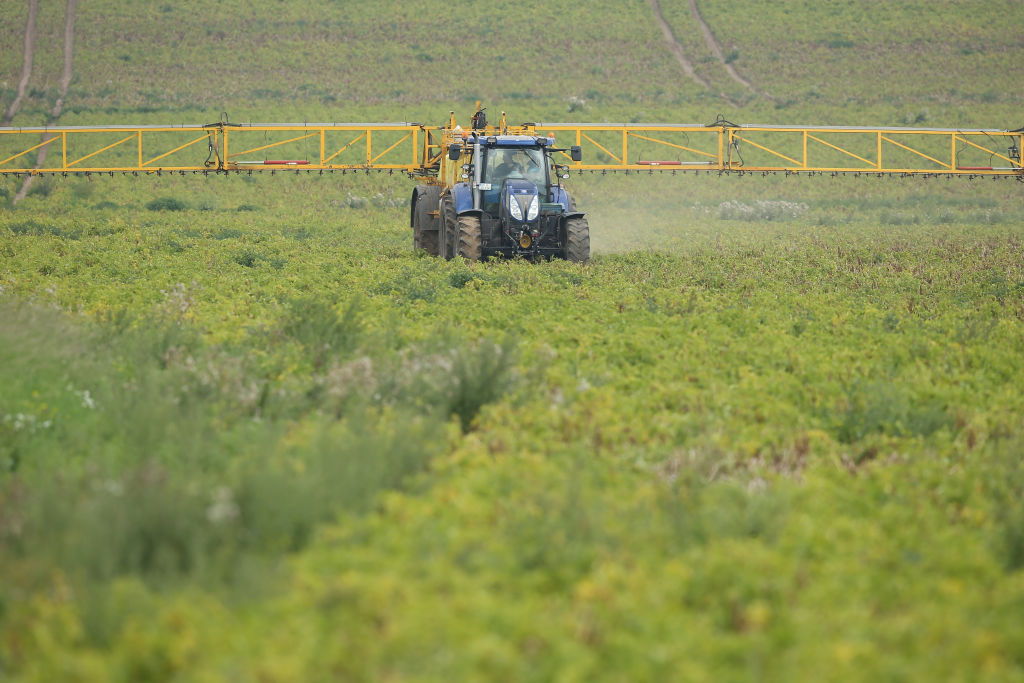A tractor sprays pesticide onto a field of potato plants. Photo by Sean Gallup/Getty Images.
Welcome to The Topline, a weekly roundup of the big numbers driving the Minnesota news cycle, as well as the smaller ones that you might have missed. This week: the link between pesticides and cancer; walking taco vs. taco in a bag; the health of Minnesota’s lakeshores; and new polling on Walz’s national favorability.
How much cancer do pesticides cause?
A study published last month in the journal Frontiers in Cancer Control and Society is making headlines for its stark findings on the relationship between agricultural pesticide use and cancer rates.
Comparing county-level pesticide application data with cancer incidence rates, the researchers found that agricultural chemicals are linked to more than half a million new cancer cases each year. More than 150,000 of those cases were located in the counties comprising the heart of the country’s corn belt, which runs from the Dakotas east through parts of Minnesota, Iowa and beyond.
Some skepticism of these findings is warranted. Half a million cases add up to more than a quarter of all new cancer cases in the U.S. each year, greater than the number caused by smoking. That’s an extraordinary claim, and validating it would require extraordinary evidence — far more than this one study, which relies on a statistical association, can provide.
While the link between smoking and cancer has been established time and time again over decades and research, the evidence on pesticides is more sparse. The American Cancer Society is circumspect in discussing pesticides, stating that “insecticides and herbicides can be toxic when used improperly in industrial, agricultural, or other workplace settings” and noting that three specific pesticide compounds have been identified as “probable human carcinogens.”
So far the strongest links between pesticides and cancer have typically been established among people who directly work with the chemicals over long periods of time. But even those studies have yielded mixed results.
As they’re fond of saying in the social sciences: More research is needed.
Do you call it a “walking taco” or a “taco in a bag”?
You’re probably familiar with the staple of midwestern cafeteria lunches and high school football concession stands. But what do you call it?
As it turns out there’s a sharp geographic divide in the terminology, at least according to data from Google Trends. While in most regions of the country “walking taco” is the preferred search nomenclature, in the Red River Valley “taco in a bag” is more commonly used. (Pronounced “bayg,” of course.)
This would be great fodder for one of those dialect quizzes that attempt to pinpoint where a person grew up by the words they use. Linguistic quirks like these are a lot of fun because they underscore how even at a time when so much of American identity — particularly in the media and political realms — is becoming national and homogenized, regional culture remains a powerful force.
In the interest of disclosure, the Reformer’s northwest Minnesota correspondent, who originally hails from upstate New York, accidentally discovered the walking taco/taco in a bag rift when he attempted to make fun of the food item on Twitter and was subsequently ridiculed by everyone.
Minnesota’s once-wild lakeshores are turning into suburban lawns
MPR News ran a great data-driven series last week on the health of Minnesota’s lakeshores. The pandemic accelerated a longstanding trend of turning wild shorelines into neatly manicured suburban-style lawns.
Those lawns and their associated concrete driveways don’t soak up rainwater and storm runoff the way wild reeds and shore plants do, so the net result has been an influx of nutrients, especially phosphorus, that fuel algae blooms in the water.
Each year roughly 2,000 permits to develop previously untouched shoreline are issued, according to MPR News, with several thousand more governing redevelopments of already built-on land.
The project finds that nearly half of the state’s wild shoreline — mostly concentrated in the southern reaches of lake country — is now gone. In the absence of political will to regulate how Minnesotans landscape their lake homes, the onus is now falling on individual landowners to protect their clear blue waters.
Vice presidential favorability
Americans have considerably more favorable views of Gov. Tim Walz than they do of Ohio Sen. J.D. Vance, according to a Washington Post poll of attitudes toward the vice-presidential candidates.
Tim Walz has a favorability rating of +9, with 39% of adults holding positive views and 30% feeling negatively. Vance’s numbers are basically flipped, at -10.
Walz is benefitting, in part, from the simple fact that he hasn’t been in the race as long as Vance and his opponents haven’t had as much time to disseminate dirt on him.
On the other hand, Vance’s opponents, most notably Walz, have had great success in painting him as a “weird guy.” This is due in large part to Vance’s lengthy history of appearing as a guest on the podcasts of various bearded right-wing extremists and agreeing with the profoundly off-putting things they say.

